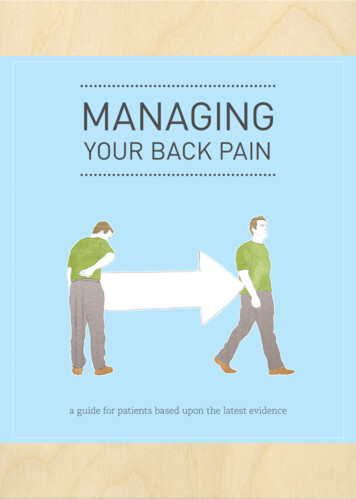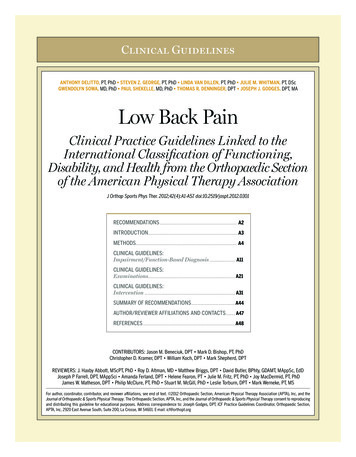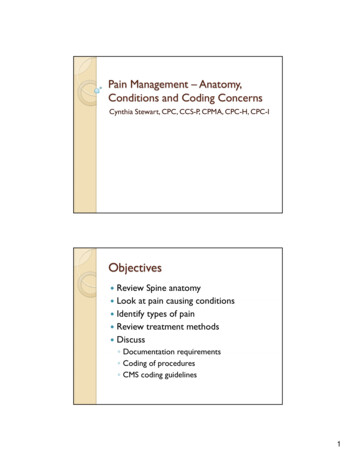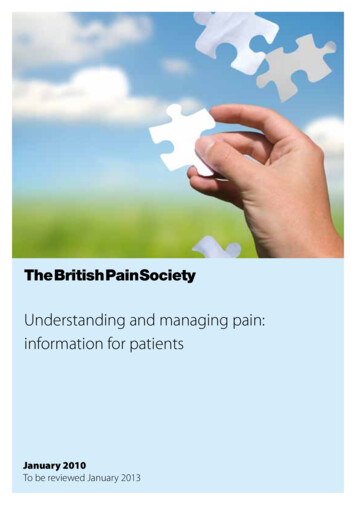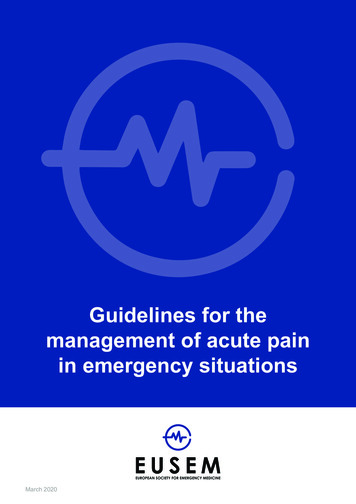
Transcription
Page 1 of 17(https://www.aetna.com/)Back Pain - Non InvasiveTreatmentsClinical Policy BulletinsMedical Clinical Policy BulletinsNumber: 0232Policy*Please see amendment for Pennsylvania Medicaidat the end of this CPB.I. Quantitative Muscle Testing DevicesAetna considers the use of quantitative muscle testing devices (e.g., MedXLumbar and Cervical Extension Devices, Isostation B-200 LumbarDynamometer, Kin-Com Physical Therapy Isokinetic Equipment, Cybex BackSystem, Biodex System 3, JTECH Tracker Freedom Wireless MusclePolicyHistoryLastReview05/07/2019Effective: 03/25/199Next Review:02/27/2020Testing) experimental and investigational when used for muscle testingbecause there is insufficient evidence that use of these devices improvesthe assessment of muscle strength over standard manual strength testingReviewsuch that clinical outcomes are improved.HistoryNote: No additional reimbursement is provided for performing manualmuscle testing using hand-held dynamometers (e.g., Lafayette ManualDefinitionsMuscle Test, Nicholas Manual Muscle Tester, Hoggan Dynamometer). Theuse of the hand-held dynamometer is considered integral to the manualmuscle testing and is not separately 00 299/0232.htmlAdditionalInformation05/30/2019
Page 2 of 17Note: Isokinetic devices (e.g., Biodex, Cybex, and Kin-Com) and otherexercise and testing machines (e.g., Isostation B-2000 and MedX) areconsidered acceptable alternatives for provision of medically necessaryexercise in physical therapy. In addition to use in muscle testing, the MedXand other machines have also been used for administering exercisetherapy. These devices can be used as exercise machines for administeringphysical therapy. However, these particular brands of exercise devices havenot been proven to be superior to standard brands of exercise equipment(e.g., Nautilus, etc.) when used for administering physical therapy.II. Orthotrac Pneumatic VestAetna considers the Orthotrac pneumatic vest, a non-surgical spinal treatment devicethat has been promoted to relieve back pain of various etiologies, experimental andinvestigational.The Orthotrac is an inflatable pneumatic vest that has been used to relieve back painfrom a variety of causes (e.g., herniated disc, spinal stenosis, facet syndrome,spondylolysthesis, etc). There is insufficient peer-reviewed published clinical evidenceof the effectiveness of the Orthotrac pneumatic vest in relieving back pain.III. Back SchoolAetna considers back school medically necessary for the treatment of persons withchronic or recurrent back pain, when such a program is prescribed by the member’sdoctor and the program is conducted by a physical therapist or otherappropriate recognized healthcare professional.See CPB 0325 - Physical Therapy Services (./300 399/0325.html).Note: Back school for occupational purposes may be excluded fromcoverage. See CPB 0250 - Occupational Therapy Services (0250.html);and CPB 0198 - Work Hardening Programs (./100 199/0198.html). Pleasecheck benefit plan descriptions for details.IV. Spinal Adjusting InstrumentsSee CPB 0107 - Chiropractic Services (./100 ta/200 299/0232.html05/30/2019
Page 3 of 17V. Khan Kinetic TreatmentAetna considers the Khan Kinetic Treatment experimental and investigational for thetreatment of back pain or any other indications because its effectiveness has not beenestablished.VI. Experimental and Investigational InterventionsAetna considers the following interventions experimental and investigational for thetreatment of back pain because their effectiveness has not been established: Auricular acupressure Cupping therapy Dr. Ho’s 2-in-1 Decompression Belt Gabapentinoids (e.g., gabapentin and pregabalin) (excludingfibromyalgia indication).See also CPB 0011 - Electrical Stimulation for Pain (./1 99/0011.html),CPB 0016 - Back Pain - Invasive Procedures (./1 99/0016.html), CPB 0132 - Biofeedback (./100 199/0132.html), CPB 0135 - Acupuncture (./100 199/0135.html),CPB 0180 - Vertebral Axial Decompression (./100 199/0180.html),CPB 0204 - Manipulation Under General Anesthesia (0204.html), CPB 0207 - Prolotherapy (0207.html),and CPB 0569 - Lumbar Traction Devices (./500 599/0569.html).BackgroundQuantitative Muscle Testing DevicesMuscle strength testing may be used to determine bilateral differences in strengthor other differences in patient resistance. These differences may be characterizedby the experienced examiner based on various technologies, i.e., manual,mechanized and computerized muscle testing. These changes may be a result ofalterations of function at various levels of the neuromuscular system and/or anyother system related to the patient. Computerized muscle testing has been used inhttp://www.aetna.com/cpb/medical/data/200 299/0232.html05/30/2019
Page 4 of 17clinical research to quantify muscle strength and enables the investigator toproduce comparison reports, quantifying patient response to rehabilitation andtherapy. However, manual muscle testing is sufficiently reliable for clinicalpractice. There is insufficient peer-reviewed published scientific evidence thatcomputerized muscle testing leads to better patient outcomes.The MedX lumbar/cervical extension machine has been proposed for use forisometric and isokinetic muscle testing and rehabilitation in persons with low backpain (LBP) and/or neck pain. The MedX lumbar/cervical extension device has notbeen adequately validated as a test of isometric and isokinetic muscle strength inpersons with back or neck pain. In addition, the MedX machine has not beenshown to be superior to any other particular brand of exercise equipment whenused for administering physical therapy. A technology assessment of the MedXLumbar Extension Machine for the treatment of LBP by the Washington StateDepartment of Labor and Industries (2003) concluded: “The evidence suggests thatMedX may help to increase lumbar muscle strength. However, studies do notclearly show MedX’s efficacy over other exercise programs.”Although there is limited evidence that when used as a training device, the MedXsystem can help to increase the strength of the lumbar as well as the cervicalextensors, it has not been proven that the MedX machines are more effective thanstandard exercise equipment in functional strengthening. Further investigation,especially controlled studies with pain patients is needed to demonstrate theaccuracy of differentiation between normal subjects and patients, especiallypatients with non-spinal cord injuries of the cervical spine. Additionally, moreresearch is needed to define the contribution of this equipment to patientmanagement, especially in relation to the significant outcomes of psychologicaldistress, changes in daily activities, and ability to return to work in such patients.The Isostation B-200 lumbar dynamometry equipment has been suggested for usefor the evaluation and rehabilitation of persons with LBP. Available evidence failsto establish the clinical effectiveness and significance of the use of the Isostation B200 lumbar dynamometer for isometric and isokinetic muscle testing (spinalmotion and trunk function) and rehabilitation in patients with LBP. More research isneeded to establish the ability of this technology to discriminate between normalsubjects and patients, to establish test-retest reliability, and to define its 200 299/0232.html05/30/2019
Page 5 of 17to and role in patient management. Additionally, further research is needed toevaluate the relationship between dynamometric technology, psychological testsand behavior assessments.The Cybex back system has been proposed for use for evaluation and rehabilitationof persons with LBP. In addition, the Cybex back system has not been proven tobe superior to any other particular brand of exercise equipment for administeringphysical therapy.It has not been proven that the Cybex system is more effective than standardexercise equipment in functional strengthening. More research is needed toincrease confidence in interpretation of abnormal range of motion and strengthdata, to define rehabilitation goals, and more importantly to define the contributionof this equipment to the management of persons with LBP, especially in relation tohealth outcomes.Other brands of isokinetic devices used for quantification of muscle strength includethe Kin-Com Isokinetic Muscle Testing Device and the Biodex Muscle TestingDevice.In a cross-sectional study, Gruther and colleagues (2009) examined the accuracyand long-term reliability of dynamometric trunk muscle strength and endurancetests in patients with chronic LBP. A total of 32 patients with chronic LBP, 19healthy controls and 15 patients with chronic headache matched for age, sex andbody mass index were included in the study. Both patient groups and healthycontrols performed isokinetic and isometric trunk extensor and flexor tests on aBiodex 2000 dynamometer. The Biering-Sørensen test served to examine backmuscle endurance. Borg-Category-Ratio-Scales CR-10 rated participants' bodyexperience immediately before and after the testing. Patients with chronic LBPrepeated measurements after 3 weeks. Among dynamometric tests, isokineticmeasurements revealed the best area under the curve (AUC 0.89) for thediscrimination between patients with chronic LBP and healthy controls. Reliabilitytesting revealed highly significant learning effects for isometric trunk flexion andisokinetic measurements. The Biering-Sørensen test demonstrated excellentaccuracy (AUC 0.93) and no learning effects. Borg-category-ratio-scale ratingswere not associated with the observed changes. The authors concluded that inpatients with chronic LBP, dynamometric trunk muscle measures are limited tomuscle function assessment purposes. Monitoring treatment outcome in thesehttp://www.aetna.com/cpb/medical/data/200 299/0232.html05/30/2019
Page 6 of 17patients with these measures appears to be problematic because of learningeffects. Based on these findings, the authors recommended the Biering-Sørensentest for management of chronic LBP rehabilitation.Hand-Held DynamometersAccording to the manufacturer, the Lafayette Manual Muscle Testing (MMT)System is an ergonomic hand-held device for objectively quantifying musclestrength. The test is performed with the clinician applying force to the limb of apatient. The objective of the test is for the clinician to overcome or “break” thepatient’s resistance. The MMT records the peak force and the time required toachieve the “break” providing reliable, accurate, and stable muscle strengthreadings that conform to most manual muscle testing protocols. The manufacturerstates that the Lafayette MMT also has customizable options for data storage,preset test times, and force thresholds.Published data on the Lafayette MMT includes small studies of its use in a researchsetting (Tsimaras et al, 2004; Klygite et al, 2003). There are no data on clinicaloutcomes with the use of the device. Other brands of hand-held dynamometersinclude the NIcholas Manual Muscle Tester and the Hoggan microFET.Khan Kinetic TreatmentThe Khan Kinetic Treatment (KKT), manufactured by Datrend Systems Inc(Richmond, British Columbia, Canada), is a medical device for the treatment ofspine-related abnormalities causing pain. According to the manufacturer, the KKTuses high-frequency small-amplitude sinusoidal waves to vibrate the vertebrae andrepeatedly activate associated neuromuscular structures, which evoke multiplemechanisms of pain relief. There is also a small unblinded randomized trial withoutplacebo control, which found that, compared with a control group, the treatmentgroup lowered both their self-recorded neck pain scores (p 0.012) and painmedication dose (p 0.048), although current functional assessmentquestionnaires (range of motion, overall activity, and recreation/work activities) didnot detect changes (p 0.233, 0.311, and 0.472, respectively) (Desmoulin et al,2007). Limitations of this study included a lack of blinding and lack of placebocontrol. Other published literature on KKT spine treatment consists of a study ofthe effect of KKT treatment in an animal model (Desmoulin et al, 2010).http://www.aetna.com/cpb/medical/data/200 299/0232.html05/30/2019
Page 7 of 17JTECH Tracker SystemThe JTECH Tracker Freedom Wireless Muscle Testing is designed for testing anddocumentation of strength loss due to injury or disease. However, there is a lack ofevidence regarding the effectiveness of the JTECH Tracker muscle testing system.Auricular AcupressureIn a systematic review and meta-analysis, Yang and associates (2017) examinedthe effects of auricular acupressure (AA) on pain and disability for patients withchronic LBP. These investigators carried out a search of RCTs in 4 Englishmedical electronic databases and 3 Chinese databases; 2 reviewers independentlyretrieved related studies, assessed the methodological quality, and extracted datawith a standardized data form. Meta-analyses were performed using all time-pointsmeta-analysis (ATM). A total of 7 trials met the inclusion criteria, of which 4 had thelow risk of bias. The findings of this study showed that, for the immediate effect, AAhad large, significant effects in improving pain within 12 weeks. As for the follow-upeffect, the pooled estimates also showed promising effect at 4-week follow-up after 4week intervention (standardized mean difference [SMD] -1.13, 95 % CI: -1.70 to-0.56), p 0.001). However, for the disability level, the therapeutic effect of AA wasnot significant (MD -1.99, 95 % CI: -4.93 to 0.95), p 0.18). No serious adverseeffects were recorded. The authors concluded that the encouraging evidence ofthis study indicated that AA can be provided to patients with chronic LBP.However, they stated that there is a pressing need for further rigorously designedlarge-scale RCTs on the effects of AA in patients with chronic LBP.The authors stated that this study had several drawbacks: (i) the limited numberof studies for analysis, especially for ATM. Only 7 eligible RCTs were evaluatedand there were only 2 or 3 RCTs included in some meta-analyses; thusinterpreting and generalizing the findings should be cautious, (ii) the originalevidence was not powerful on the whole considering the small sample sizes;and, to the authors’ knowledge, some study parameters of implementation(i.e., selection of acupoints, instructions of manual pressing, and duration ofAA) were confirmed to be crucial influential factors for therapeutic effect thatcan impact the overall quality of the RCTs. In the future, these investigatorshope systematic review can be updated based on more rigorous and powerfulevidence, and (iii) the use of different interventions (e.g., Tai Chi exercise,walking training, and placebo) in controls may prevent these researchers fromhttp://www.aetna.com/cpb/medical/data/200 299/0232.html05/30/2019
Page 8 of 17drawing firm conclusions about the effectiveness of AA. Moreover, onlypublished studies were included in this study, leaving the unpublished negativeresults out of consideration may lead to the less powerful results.Cupping TherapyIn a meta-analysis, Wang and colleagues (2017) evaluated the safety andeffectiveness of cupping therapy for the patients with LBP. PubMed, CochraneLibrary databases, and Embase database were electronically researched; RCTsreporting the cupping for the patients with LBP were included. The meta-analysiswas conducted using Review Manager software (version 5.3, Nordic CochraneCentre). The primary outcome was VAS scores; the secondary outcomes includedODI scores, McGill Present Pain Intensity (MPPI) scores and complications. A totalof 6 RCTs were included in this synthesized analysis. The results showed thatcupping therapy was superior to the control management with respect to VASscores (SMD: -0.73, [95 % CI: -1.42 to -0.04]; p 0.04), and ODI scores (SMD:-3.64, [95 % CI: -5.85 to -1.42]; p 0.001). There was no statistical significantdifference as regard to MPPI scores. No serious adverse event (AE) was reportedin the included studies. The authors concluded that cupping therapy couldsignificantly decrease the VAS scores and ODI scores for patients with LBPcompared to the control management. Moreover, they stated that highheterogeneity and risk of bias existing in studies limited the authenticity of thefindings.GabapentinoidsIn a systematic review and meta-analysis, Shanthanna and colleagues (2017)evaluated the safety and effectiveness of gabapentinoids in adult chronic LBP(CLBP) patients. Electronic databases of Medline, Embase, and Cochrane weresearched from their inception until December 20, 2016. These researchersincluded RCTs reporting the use of gabapentinoids for the treatment of CLBP ofgreater than 3 months duration, in adult patients. Study selection and dataextraction was performed independently by paired reviewers. Outcomes wereguided by Initiative on Methods, Measurement and Pain Assessment in ClinicalTrials guidelines, with pain relief and safety as the primary outcomes. Metaanalyses were performed for outcomes reported in 3 or more studies. Outcomeswere reported as mean differences (MDs) or RRs with their corresponding 95 %CIs, and I2 in percentage representing the percentage variability in effect estimateshttp://www.aetna.com/cpb/medical/data/200 299/0232.html05/30/2019
Page 9 of 17that could be explained by heterogeneity. GRADE (Grading of RecommendationsAssessment, Development, and Evaluation) was used to assess the quality ofevidence. Out of 1,385 citations, 8 studies were included. Based on theinterventions and comparators, studies were analyzed in 3 different groups.Gabapentin (GB) compared with placebo (3 studies, n 185) showed minimalimprovement of pain (MD 0.22 units, 95 % CI: -0.5 to 0.07, I2 0 %; GRADE:very low); 3 studies compared pregabalin (PG) with other types of analgesicmedication (n 332) and showed greater improvement in the other analgesic group(MD 0.42 units, 95 % CI: 0.20 to 0.64, I2 0; GRADE: very low). Studies usingPG as an adjuvant (n 423) were not pooled due to heterogeneity, but the largestof them showed no benefit of adding PG to tapentadol. There were no deaths orhospitalizations reported. Compared with placebo, the following AEs were morecommonly reported with GB: dizziness (RR 1.99, 95 % CI: 1.17 to 3.37, I2 49);fatigue (RR 1.85, 95 % CI: 1.12 to 3.05, I2 0); difficulties with mentation (RR 3.34, 95 % CI: 1.54 to 7.25, I2 0); and visual disturbances (RR 5.72, 95 % CI:1.94 to 16.91, I2 0). The number needed to harm with 95 % CI for dizziness,fatigue, difficulties with mentation, and visual disturbances were 7 (4 to 30), 8 (4 to44), 6 (4 to 15), and 6 (4 to 13) respectively. The GRADE evidence quality wasnoted to be very low for dizziness and fatigue, low for difficulties with mentation,and moderate for visual disturbances. Functional and emotional improvementswere reported by few studies and showed no significant improvements. Theauthors concluded that existing evidence on the use of gabapentinoids in CLBP islimited and demonstrated significant risk of adverse effects without anydemonstrated benefit. They stated that given the lack of effectiveness, risks, andcosts associated, the use of gabapentinoids for CLBP merits caution. Moreover,they stated that there is need for large high-quality clinical trials to more definitivelyinform this issue.Fibromyalgia (FM) includes symptoms of widespread musculoskeletal pain.Furthermore, FM may complicate regional pain disorders such as chronic low backpain. The American College of Rheumatology (ACR) guideline-approvedfibromyalgia medications include gabapentinoids, such as pregabalin andgabapentin (Goldenberg, 2017).Decompression Belthttp://www.aetna.com/cpb/medical/data/200 299/0232.html05/30/2019
Page 10 of 17Cannon and colleagues (2016) evaluated the ability of a pneumatic decompressionbelt to restore spinal height lost following an acute bout of exercise that inducedcompression. This study implemented a test-retest repeated measures design inwhich 12 participants (2 women and 10 men) aged 21.5 1.0 years; height, 179.0 7.70 cm; weight, 84.0 11.5 kg; were recruited from a university population andacted as their own control. All participants were healthy with no previous history ofdisabling back pain, and were frequent weight-trainers. A stadiometer was used tomeasure spinal height at baseline, then following an acute bout of exercise andthen again following the intervention (use of a pneumatic decompression belt for 20mins) or control (lying supine for 20 mins). A 2-way repeated measures ANOVAwas performed on the change in spinal height in order to evaluate differencesbetween measurement phases and intervention conditions. The use of thedecompression belt increased spinal height gain (4.3 3.0 mm) significantly morethan the control condition (1.8 1.2 mm) following an acute bout of weight-liftingexercises known to elicit high compressive loads on the lumbar spine. The authorsconcluded that the pneumatic decompression belt restored spinal height faster thana non-belt wearing condition in young healthy asymptomatic participants. This wasa small study (n 12); and it did not include patients with back pain.Furthermore, an UpToDate review on “Subacute and chronic low back pain:Nonpharmacologic and pharmacologic treatment” (Chou, 2018) does not mentiondecompression or pneumatic belts as a therapeutic option.CPT Codes / HCPCS Codes / ICD-10 CodesInformation in the [brackets] below has been added for clarificationpurposes. Codes requiring a 7th character are represented by " ":CodeCode DescriptionCPT codes covered if criteria are met:97110Therapeutic procedure, one or more areas, each 15 minutes;therapeutic exercises to develop strength and endurance, range ofmotion and flexibility97140Manual therapy techniques (e.g., mobilization/manipulation, manuallymphatic drainage, manual traction), one or more regions, each 15minuteshttp://www.aetna.com/cpb/medical/data/200 299/0232.html05/30/2019
Page 11 of 17CodeCode Description97530Therapeutic activities, direct (one-on-one) patient contact (use ofdynamic activities to improve functional performance), each 15 minutes[not covered for Khan Kinetic Treatment]CPT codes not covered for indications listed in the CPB:Hand held dynamometer, auricular acupressure, cupping therapy - no specific code:95831Muscle testing, manual (separate procedure) with report; extremity(excluding hand) or trunk [Lafayette manual muscle testing]95851Range of motion measurements and report (separate procedure); eachextremity (excluding hand) or each trunk section (spine)97545 97546Work hardening/conditioning; initial 2 hourseach additional hour (List separately in addition to code for primaryprocedure)97750Physical performance test or measurement (e.g., musculoskeletal,functional capacity), with written report, each 15 minutesHCPCS codes covered if selection criteria are met:S9117Back school, per visitHCPCS codes not covered for indications listed in the CPB:Gabapentinoids (e.g., gabapentin and pregabalin), Dr. Ho’s 2-in-1 Decompression Belt - nospecific code:ICD-10 codes covered if selection criteria are met:M54.00 - M54.9Back painThe above policy is based on the following references:Quantitative Muscle Testing Devices1. Newton M, Waddell G. Trunk strength testing with iso-machines. Part 1:Review of a decade of scientific evidence. Spine. 1993;18(7):801-811.2. Newton M, Thow M, Somerville D, et al. Trunk strength testing with isomachines. Part 2: Experimental evaluation of the Cybex II back testing systemin normal subjects and patients with chronic low back pain. Spine. l/data/200 299/0232.html05/30/2019
Page 12 of 173. Mostardi RA, Noe DA, Kovacik MW, Porterfield JA. Isokinetic lifting strengthand occupational injury. A prospective study. Spine. 1992;17(2):189-193.4. Mellin G, Harkapaa K, Vanharanta H, et al. Outcome of a multimodaltreatment including intensive physical training of patients with chronic lowback pain. Spine. 1993;18(7):825-829.5. Mooney V, Kenney K, Leggett S, Holmes B. Relationship of lumbar strength inshipyard workers to workplace injury claims. Spine. 1996;21(17):2001-2005.6. Teasell RW, Harth M. Functional restoration: Returning patients with chroniclow back pain to work -- revolution of fad? Spine. 1996;21(7):844-847.7. Timm KE. A randomized-control study of active and passive treatments forchronic low back pain following L5 laminectomy. J Orthop Sports Phys Ther.1994;20(6):276-286.8. Madsen OR. Trunk extensor and flexor strength measured by the Cybex 6000dynamometer. Spine. 1996;21:2770-2776.9. Dueker JA, Ritchie SM, Knox TJ, Rose SJ. Isokinetic trunk testing andemployment. J Occup Med. 1994;36(1):42-48.10. Sachs BL, Ahmad SS, LaCroix M, et al. Objective assessment for exercisetreatment on the B-200 Isostation as part of work tolerance rehabilitation: Arandom prospective blind evaluation with comparison control population.Spine. 1994;19(1):49-52.11. Ohnmeiss DD, Vanharanta H, Estlander AM, et al. The relationship ofdisability (Oswestry) and pain drawings to functional testing. Eur Spine J.2000;9(3):208-212.12. Ganzit GP, Chisotti L, Albertini G, et al. Isokinetic testing of flexor andextensor muscles in athletes suffering from low back pain. J Sports Med PhysFitness. 1998;38(4):330-336.13. Bronfort G, Evans R, Nelson B, et al. A randomized clinical trial of exerciseand spinal manipulation for patients with chronic neck pain. Spine. 2001;26(7):788-799.14. Bouilland S, Loslever P, Lepoutre FX. Biomechanical comparison of isokineticlifting and free lifting when applied to chronic low back pain rehabilitation. MedBiol Eng Comput. 2002;40(2):183-192.15. Jackson N. Exercise therapy for the treatment of chronic low back pain.Evidence Centre Evidence Report. Clayton, VIC: Centre for ClinicalEffectiveness (CCE); 2002.16. Evans R, Bronfort G, Nelson B, Goldsmith CH. Two-year follow-up of arandomized clinical trial of spinal manipulation and two types of exercise forpatients with chronic neck pain. Spine. ical/data/200 299/0232.html05/30/2019
Page 13 of 1717. Helmhout PH, Harts CC, Staal JB, et al. Comparison of a high-intensity and alow-intensity lumbar extensor training program as minimal interventiontreatment in low back pain: A randomized trial. Eur Spine J. 2004;13(6):537547.18. Walsworth M. Lumbar paraspinal electromyographic activity during trunkextension exercises on two types of exercise machines. Electromyogr ClinNeurophysiol. 2004;44(4):201-207.19. Washington State Department of Labor and Industries, Office of the MedicalDirector. MedX Lumbar Extension Machine for the treatment of low back pain.Technology Assessment. Olympia, WA: Washington State Department ofLabor and Industries; November 7, 2003. Available a110703.pdf. AccessedNovember 4, 2005.20. de Koning CH, van den Heuvel SP, Staal JB, et al. Clinimetric evaluation ofmethods to measure muscle functioning in patients with non-specific neckpain: A systematic review. BMC Musculoskelet Disord. 2008;9:142.21. Gruther W, Wick F, Paul B, et al. Diagnostic accuracy and reliability ofmuscle strength and endurance measurements in patients with chroniclow back pain. J Rehabil Med. 2009;41(8):613-619.Orthotrac Pneumatic Vest1. Orthofix Inc. Orthotrac pneumatic decompression. McKinney, TX: Orthofix;2005. Available at: http://www.orthofix.com/ofus/mainbody.htm. AccessedApril 8, 2005.2. van Duijvenbode ICD, Jellema P, van Poppel MNM, van Tulder MW. Lumbarsupports for prevention and treatment of low back pain. Cochrane DatabaseSyst Rev. 2008;(2):CD001823.3. Dallolio V. Lumbar spinal decompression with a pneumatic orthosis(Orthotrac): Preliminary study. Acta Neurochir Suppl. 2005;92:133-137.4. Mahoney CB. Treating low back pain: The effect of the OrthotracPneumatic Vest on the cost of treatment and quality of life.CareManagement. 2001;7(4):27-31.Back Schoolshttp://www.aetna.com/cpb/medical/data/200 299/0232.html05/30/2019
Page 14 of 171. Bigos S, Boyer O, Braen G, et al. Acute low back problems in adults. ClinicalPractice Guideline No. 14. AHCPR Publication No. 95-0642. Rockville, MD:Agency for Health Care Policy and Research (AHCPR); December 1994.2. Nordin M, Cedraschi C, Balague F, Roux EB. Back schools in prevention ofchronicity. Baillieres Clin Rheumatol. 1992;6(3):685-703.3. Raspe H, Kohlmann T, Luhmann D. The evaluation of back schoolprogrammes as medical technology - systematic review. Koln, Germany:German Agency for Health Technology Assessment at the German Institutefor Medical Documentation and Information; 1997.4. Koes BW, van Tulder MW, van der Windt WM, Bouter LM. The efficacy ofback schools: A review of randomized clinical trials. J Clin Epidemiol. 1994;47(8):851-862.5. Di Fabio RP. Efficacy of comprehensive rehabilitation programs and backschool for patients with low back pain: A meta-analysis. Physical Ther.1995;75(10):865-878.6. Revel M. Rehabilitation of low back pain patients. A review. Rev Rhum EnglEd. 1995;62(1):35-44.7. Linton SJ, Kamwendo K. Low back schools. A critical review. Phys Ther.1987;67(9):1375-1383.8. Nachemson A, Carlsson CA, Englund L, Goossens M. Back and neck pain.Report No. 145. Stockholm, Sweden: Swedish Council on TechnologyAssessment in Health Care (SBU); 2000.9. NHS Centre for Reviews and Dissemination. Acute and chronic low back pain.Effective Health Care. York, UK: NHS Centre for Reviews and Dissemination;2000;6(5).10. Heymans MW, van Tulder MW, Esmail R, et al. Back schools for non-specificlow back pain. Cochrane Database Syst Rev. 2004;(4):CD000261.11. Heymans MW, Van Tulder MW, Esmail R, et al. Back schools for nonspecificlow ba
The Orthotrac is an inflatable pneumatic vest that has been used to relieve back pain from a variety of causes (e.g., herniated disc, spinal stenosis, facet syndrome, spondylolysthesis, etc). There is insufficient peer-reviewed published clinical evidence of the effectiveness of the Orthotrac pneumatic vest in relieving back pain. III. Back School

